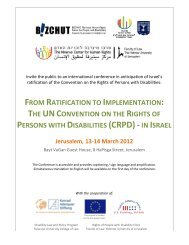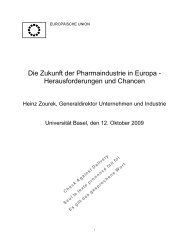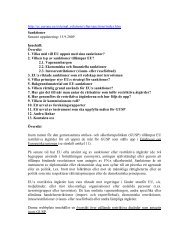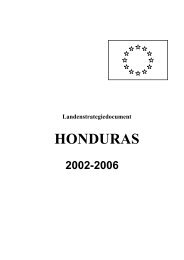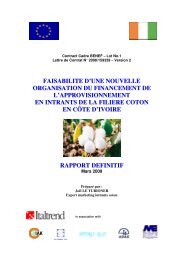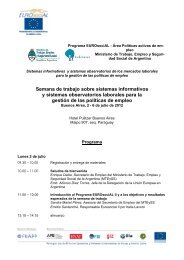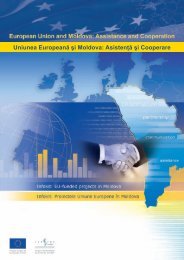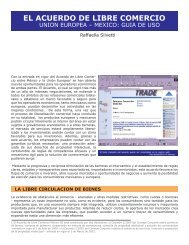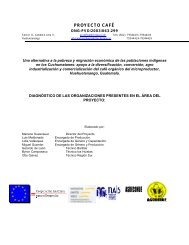RESOURCE COMPETITION IN THE 21ST CENTURY
RESOURCE COMPETITION IN THE 21ST CENTURY
RESOURCE COMPETITION IN THE 21ST CENTURY
Create successful ePaper yourself
Turn your PDF publications into a flip-book with our unique Google optimized e-Paper software.
Resource co m p e t i t i o n in th e 21 st ce n t u r yIntroductionAs in previous epochs, the world of the21 st century faces a variety of political,economic, social and ecological pressuresthat threaten stability in many areas of theglobe and embody a potential for violentconflict. Many of these pressures are akinto those that have imperilled regional andinternational stability in the past: ethnicand religious antagonisms, the struggle fordominance between aspiring and establishedpowers, territorial disputes, economic competition,and so on. It is likely, however, thatadditional sources of friction and instabilitywill arise in this century, emerging fromthe distinctive features of the current era.Of these, one of the most significant willbe global competition for access to scarceor vital supplies of critical resources: water,oil, natural gas, arable land and key industrialminerals. 1Facing resource competitionThe significant role played by resourcecompetition in sparking conflict is evidentin many of the recent outbreaks of armedviolence, such as those in Aceh, Angola,Chad, Chechnya, Chiapas, Colombia, Congo,Congo-Brazzaville, Iraq, Liberia, SierraLeone, Somalia and Sudan. Like all humanconflicts, these upheavals have more thanone cause; all, however, are driven to a considerableextent by competition over vitalor valuable resources: diamonds in the caseof Angola, Liberia, and Sierra Leone; oilin the case of Aceh, Chechnya, Colombia,Congo-Brazzaville, Iraq and Sudan; timberand minerals in the Congo; arable land inChiapas and Zimbabwe; and so on.It is true, of course, that competition overscarce and vital materials has long been asource of conflict. Indeed, many of the earliestrecorded wars — notably those occurringin ancient Mesopotamia, Egypt and theJordan River valley — were driven by strugglesover the control of critical water sourcesand arable land. Similarly, many of the warsof the 16th through to the early 20th centurywere sparked by competition betweenthe major European powers for control overresource-rich colonies in Africa, Asia, theEast Indies and the New World — strugglesthat culminated in the First World War. Therise of Nazism and the US-Soviet rivalry ofthe Cold War era tended to overshadow (butnot eliminate) the importance of resourcecompetition in the mid-20th century, but theend of the Cold War brought this factor onceagain to the fore, as evinced by the conflictsidentified above.One can argue, then, that the re-emergenceof resource conflict in the current periodis nothing more than a return to thestatus quo ante: to the long stretch of timein which resource competition was a dominantforce in world affairs. But it is the contentionof this chapter that the situation weface today is not just more of the same: itis, instead, a qualitatively different situation,in which resource competition has assumeda more decisive and central role in armedconflict than has been the case in the past.To appreciate this, it is necessary to considerboth the importance of key resourcesto contemporary human endeavours andthe unique pressures on the world’s resourcebase at the onset of the 21 st century.Some resources are, of course, essentialfor human survival. All humans need a certainamount of food and water, plus accessto shelter, clothes and, in northern climates,heat. At a very primitive level of existence,human societies can function on relativelymodest quantities of these materials, so longas their numbers remain few. As societiesgrow more complex, they require more resourcesfor their own use and to producetrade goods to exchange for the things theylack, including luxury items sought by theirelites. Modern means of warfare also consumesvast quantities of resources, especiallypetroleum to fuel the tanks, planes, helicoptersand ships that have come to dominateMichael T. Klare is the Five College Professorof Peace and World Security Studies (a jointappointment at Amherst College, HampshireCollege, Mount Holyoke College, and SmithCollege and the University of Massachusettsat Amherst), a position he has held since1985. Professor Klare has written widely onUS defence policy, global resource politics andworld security affairs.1 The author first articulated this argument in Michael T. Klare (2001). Resource Wars: The new landscape of global conflict. New York: Metropolitan Books.[ 293 ]
the contemporary battlefield. The more developed,urbanised, and prosperous a society,the greater its requirement for all resourcesof all types.The dilemma that confronts us at thedawn of the 21 st century is the fact that humanconsumption of almost all types of materialsis growing at an ever-increasing rate,imposing growing and possibly intolerablepressures on the world’s existing stockpile ofnatural resources. Until now, humans havebeen able to mitigate these pressures by developingnew sources of supply — for example,by digging deeper into the earth formetals and oil — and by inventing alternativematerials. No doubt human ingenuityand the power of the market will continueto generate solutions of this sort. At somepoint, however, the demand for certain vitalresources will simply overwhelm the availablesupply, producing widespread shortagesand driving up the price of what remains; insome cases, moreover, it may prove impossibleto develop viable substitutes. (There isno known substitute, for example, for freshwater). As resource stocks dwindle and pricesrise, the divide between those with accessto adequate supplies and those withoutwill widen, straining the social fabric and insome cases leading to violent conflict. 2Even if disputes over the distributionof resources do not result in violence, thestresses engendered by resource pressureswill affect human society in several ways.For many countries, the tempo of economicgrowth will decline as domestic suppliesof vital materials contract and the price ofimports rises. For those states still in possessionof valuable resources, the impulseto extract and sell as much as possiblewhile prices are high could lead to severeand costly environmental damage. And theentire planet will suffer from the by-productsof unrestrained resource consumption— among them, increased greenhouse-gasemissions, the build-up of toxic wastes, fisheriescollapse, biodiversity loss and severesoil degradation.It is apparent, then, that resource competitionwill play an increasingly significant rolein world affairs as time proceeds. Just howsubstantial its impact will be will depend, toa considerable extent, on the evolution ofhuman consumption patterns. The greaterthe pressure we bring to bear on the world’sexisting resource base, the higher the risk ofmajor social and environmental trauma. It isessential, then, to consider the implicationof five key trends in contemporary humanbehaviour: globalisation, population growth,urbanisation and resource depletion.GlobalisationThe growing internationalisation of finance,manufacturing and trade is havinga powerful effect on many aspects of humanlife, including the demand for and consumptionof basic resources. Globalisationincreases the demand for resources in severalways. Most significant is the spread ofindustrialisation to more and more areas ofthe world, producing a dramatic increase inthe demand for energy, minerals and otherbasic commodities.The spurt in demand for energy is especiallyevident in the newly industrialisedcountries of Asia, which are expected tocontinue growing at a rapid pace in thecoming decades. According to the US Departmentof Energy (DoE), energy consumptionin developing Asia (including China,India, South Korea and Taiwan) will growby an estimated 3.2 per cent per year duringthe first three decades of the 21 st century,producing a net increase in demand ofmore than 215 per cent over this period. Thegrowth in demand for petroleum will be particularpronounced, with total consumptionin developing Asia jumping from 14 millionbarrels per day in 2001 to 30 million barrelsin 2030. 3 A similar pattern is evident withrespect to consumption of natural gas andcoal — both of which are projected to experiencea substantial increase in demand inthis region in the coming decades. The risingconsumption energy, along with other materialsneeded to sustain economic growthin the newly industrialised countries, will2 For discussion, see Thomas Homer-Dixon, ‘Environmental scarcities and violent conflict,’ International Security, vol. 19, no. 1 (summer 1994), p. 5-40.3 US Department of Energy, Energy Information Administration (DoE/EIA), International Energy Outlook 2007 (Washington, D.C.: DoE/EIA, 2007), tables A1 and A5, p. 83, 88.[ 294 ]
significantly increase the pressures alreadybeing placed on the global resource base.Globalisation is further adding to the pressureon resources by contributing to theemergence of a new middle class in manyparts of the world. As families acquire additionalincome, they tend to acquire moregoods and appliances, eat higher-end foods(such as beef, pork and chicken), and to moveinto larger living quarters — all of whichgenerates a steep increase in the consumptionof basic materials. Most significant inthis regard is the growing international demandfor private vehicles, a process knownas the ‘motorisation’ of society. The motorisationrate (usually measured in number ofvehicles per thousand population) is skyrocketingin many developing countries aseconomic growth accelerates and personalincome rises. ‘In many urban centres, suchas Bangkok, Manila, Jakarta, Shanghai, andMumbai, car ownership is among the firstsymbols of emerging prosperity’. 4 By 2020,the global population of motor vehicles willgrow to an estimated 1.1 billion units — 425million above the level for 1996. 5 Just toproduce all of these vehicles will entail theconsumption of vast amounts of iron, aluminiumand other minerals; once in operation,they will consume millions of gallonsof oil per day, year after year.Finally, globalisation affects the global resourceequation by extending the worldwidereach of multinational companies (MNCs),generating significant economic benefits formany poor and isolated countries but alsoproviding incentives for cash-starved governmentsto permit the extraction of rawmaterials beyond sustainable levels or thedestruction of forests to make way for export-orientedranching and agriculture. Theever-expanding reach of MNCs also facilitatesthe entry of warlords, insurgent groupsand corrupt military factions into resourcerelatedenterprises. In many cases, these actorshave used their ties to such firms tofinance the illicit acquisition of arms andother military items. In Liberia, for example,the rebel force once led by Charles Taylortraded timber and mineral rights for the cashneeded to purchase arms and ammunition;in Sierra Leone and Angola, the rebels tradeddiamonds for guns. 6 These transactionshave increased the duration and severity ofa number of internal conflicts, producingvast human suffering and placing a mammothburden on the world’s humanitarianaid organisations.Population growthRising population is further adding to thepressures on the world’s resource base. Accordingto the World Resources Institute(WRI), total world population will reach approximately8 billion people in 2025, or twobillion more than the number in 2000. Thesetwo billion additional people will need to befed, housed, clothed and otherwise providedwith basic necessities — producing a correspondingrequirement for food, water, wood,metals, fibres and other materials. Althoughthe earth can supply these materials, at leastin the amounts needed for a relatively modeststandard of living, it cannot continueto sustain an ever-growing human populationand satisfy the rising expectationsof the world’s middle and upper classes. Atsome point, significant shortages will occur,intensifying the competition for accessto remaining supplies and producing severehardship for those without the means to paythe higher prices thereby incurred.Of all basic necessities, the one that is mostlikely to be affected by population growthis fresh water. Humans must have access toa certain amount of water every day, fordrinking, personal hygiene and food production.Fortunately, the world possesses sufficientrenewable supplies of fresh water tosatisfy current requirements and to sustainsome increase in the human population. Butthe pressure on many key sources of supplyis growing, suggesting that severe shortageswill develop in some water-scarce areas over4 Doe/EIA, International Energy Outlook 1999, p. 133.5 Ibid., p. 117.6 On Liberia, see William Reno, ‘Reinvention of an African patrimonial state: Charles Taylor’s Liberia’, Third World Quarterly, vol. 16, no. 1 (1995), pp. 109-20.On Sierra Leone, see Douglas Farah, ‘Diamonds are a rebel’s best friend’, Washington Post, 17April 2000.[ 295 ]
the next few decades. This is especially truein the Middle East and North Africa, wherefresh water is already in short supply andpopulation growth rates are among the highestin the world. For example, the number ofpeople who will be relying on the Nile River,the Jordan River and the Tigris—Euphratessystem for all or most of their water supplywill grow from approximately 325 millionin 2000 to 740 million in 2050 — withoutany appreciable increase in the net supplyof water in the region. Unless the existingsources of supply are used more efficiently,or the desalination of seawater proves moreaffordable, competition over access to waterwill become more intense in these areas andcould lead to war. 7Population growth is also likely to placegrowing pressure on the world’s supply ofarable land. This is especially true in thedeveloping areas, where many people stillrely on agriculture for their basic survival orfor family income. As population expands,farmers tend to crop their existing plots moreintensively or to bring marginal lands intocultivation, thereby depleting the soil of essentialnutrients and risking the onset oferosion. The ever-growing demand for croplandalso leads to the accelerated clearingof virgin forests, eradicating the habitats ofmany unique plant and animal species.UrbanisationClosely related to population growth butadding distinctive pressures of its own is thegrowing concentration of humans in largetowns and cities. Throughout the world —but especially in the developing world —people are moving from rural to urban areas,and from small to large cities. According toWRI, the world’s urban population surgedfrom 1.5 billion people in 1975 to 2.6 billionin 1995, and is expected to jump againto 5.1 billion by the year 2025. 8 In manycases, moreover, people are moving to verylarge cities: by 2015, an estimated 1.7 billionpeople (nearly one-fourth of the world’stotal population) will be living in cities ofover 1 million people. 9 This has enormousimplications for global resource stocks, asurban communities tend to consume moreenergy, water and building materials, and togenerate far more waste products than ruralareas. The outward expansion of cities andsuburbs is also usurping areas previouslyused for agriculture, thereby adding to thepressure on the world’s remaining supply ofarable land. 10From a resource perspective, the impact ofurbanisation cannot always be distinguishedfrom that of globalisation and populationgrowth. All of these phenomena are addingto the worldwide demand for water, energyand other basic commodities. But the concentrationof more and more people in largecities does have a particularly pronouncedimpact on global water supplies, as urbanareas require vast quantities of water forsanitation and personal use, and also becausecities produce copious waste productsthat are often poured into rivers and lakes— thereby diminishing the amount of cleanwater available to other users. Providingadequate supplies of water to large urbancentres and neighbouring areas, therefore,prove to be one of the most demanding tasksfacing local and national leaders in the 21 stcentury.Resource depletionThe three factors described above —globalisation, population growth and urbanisation— are combining to create a fourth:the irreversible depletion of some nonrenewableresources. While the earthcontains large amounts of many of the mostvital materials, these supplies are not unlimitedand can be exhausted through excessiveextraction or utilisation. And, in the case ofsome vital resources, humans have reachedthis point or are likely to do so in the earlydecades of the 21 st century. For example,humans have harvested some species of fish(such as the once-prolific cod) so intensivelythat they have virtually disappeared from7 For background and data, see Peter H. Gleick (ed.), Water in Crisis: A guide to the world’s fresh water resources (New York and Oxford: Oxford University Press, 1993);Sandra Postel, Last Oasis: Facing water scarcity (New York: W.W. Norton, 1997).8 World Resources Institute (WRI) (1996). World Resources 1996-1997. New York and Oxford: Oxford University Press, p. 150.9 See World Resources Institute (1996), op. cit., p. 9.10 For discussion, see World Resources Institute (1996) op. cit., pp. 57-80.[ 296 ]
the world’s oceans and are not expected torecover. Similarly, some valuable types ofhardwood have largely disappeared from theworld’s forests.Of the resources that are facing depletionin the decades ahead, none is more importantto human life and society than naturalpetroleum. Oil supplies about two-fifth’s ofthe world’s basic energy supply — more thanany other source — and provides about 97per cent of the energy used for transportation.It is an essential feedstock for manyvaluable products, including plastics, fertilisers,pesticides, asphalt and certain pharmaceuticals.Petroleum is also a non-renewableresource: once we consume the existingworld supply (produced by geological processesmany eons ago), there will be noneleft for future generations. So far, humanshave consumed nearly one-half of the earth’soriginal petroleum inheritance (1.0 trillionbarrels out of the 2.2 trillion barrels thatare thought to have existed in 1860, whencommercial extraction began), but we areextracting oil at such an intensive rate thatmuch of the remaining supply could disappearin the next 30-40 years. The introductionof new technologies and fuel sources— such as ethanol, coal-to-liquids and hydrogen-poweredfuel cells — could slow therate of oil depletion in the years ahead, butat present we are continuing to increase ourtotal consumption year after year.Fresh water is a renewable resource andso will never disappear, but it can be viewedas a non-renewable substance because theearth’s habitable areas only receive a certainamount of it each year in the form ofprecipitation. Of this amount — approximately110,000 km 3 — a large share is lostto evaporation, discharge into the oceansand absorption by plants and the soil, leavingonly 12,500 km 3 for use by humans. Atpresent, we are using approximately half ofthis supply, and are increasing our utilisationat such a high rate (because of populationgrowth, urbanisation, industrialisationand irrigated agriculture) that we will beginto approach full utilisation by the middleof the century — at which point billions ofpeople can be expected to suffer from severewater shortages.Global climate changeAll of these problems are bound to be exacerbatedby the effects of global climatechange. Although climate scientists cannotbe certain about the future effects of climatechange on any particular locale, they are increasinglyconvinced that large parts of theplant will suffer from persistent droughts, diminishedrainfall, and the invasion of coastalareas by a rise in the sea level. This will,in turn, jeopardise water supplies and foodproduction in many tropical and temperateareas of the world, forcing millions ofpeople — perhaps tens or even hundreds ofmillions — to abandon their ancestral landsand migrate to other, less-severely affectedareas. The result could well be an increasein conflict over access to fresh water andarable land. 11Climate change will also effect the planet’senergy equation in various ways. An increasein severe storm activity, for example,will endanger oil and natural gas productionin such key producing areas as the Gulf ofMexico, the Persian Gulf and the North Sea.Because so much of America’s oil production,distribution and refining is concentratedin the Gulf of Mexico area, future stormslike 2005’s Hurricane Katrina will have adevastating effect on the nation’s oil output.The reduced levels of rainfall expectedfrom global warming in many parts of theworld will also reduce the flow of water intomany rivers that have been dammed for thepurpose of generating electricity; with lessrainfall, these hydro-electricity plants couldsit idle for long stretches of time.The potential for conflictTogether, these factors are producing increasingpressure on the world’s resourcebase — pressure that can only increase aswe proceed deeper into the 21 st century. Theresulting shortages are likely to produce ormagnify antagonisms between and withinsocieties as governments and factionscompete for access to or control over major11 See the 2007 report of Working Group II of the Intergovernmental Panel on Climate Change (IPCC), Climate Change 2007: Impacts, adaptation, and vulnerability, available on-line at www.ipcc.ch.See also Michael T. Klare, ‘Global warming battlefields: how climate change threatens security’, Current History, November 2007, pp. 355-61.[ 297 ]
sources of vital materials. In the extremecase, such antagonisms can lead to the outbreakof armed violence.In general, violent struggle over resourcescan take one of four forms: first, territorialdisputes between competing states over theownership of contested border zones or offshoreareas harbouring valuable supplies ofcritical materials; access conflicts arisingfrom efforts by an outside power to gain orpreserve access to a foreign source of criticalmaterials; allocation disputes arising fromdisagreements over the distribution of suppliesfrom a shared resource source (such asa multinational river system); and revenuedisputes arising from struggles between contendingfactions for monopolisation of therents or profits generated by control over avaluable resource source, such as an oil fieldor copper mine, or the illicit traffic in ‘lootable’goods, like diamonds or old-growth timber.Most of the conflicts of the post-ColdWar era embody aspects of one or anotherof these conflict types.Territorial disputesTerritorial disputes, arising from disputedclaims to contested lands have been a sourceof friction and conflict throughout humanhistory and still occasionally provoke armedviolence — the 1998-2000 war between Eri-trea and Ethiopia being a conspicuous example— but have become less frequent inrecent years as states have slowly but surelyresolved outstanding boundary disputes.Conflicts over offshore territories, however,appear to be becoming more frequent asgovernments fight over contested maritimeEEZs (exclusive economic zones) with valuablefisheries and undersea resources, suchas oil and natural gas. For example, Chinahas fought with Vietnam and the Philippinesover ownership of the Spratly Islandsin the South China Sea, a potential source ofenergy; likewise, Iran and Azerbaijan haveclashed over disputed offshore territoriesin the Caspian Sea. 12 So long as states seea vital national interest in controlling suchareas, disputes over contested EEZs will be arecurring factor in international affairs.Access conflictsAccess conflicts arise from efforts by a resource-importingnation to ensure its abilityto procure needed resources from a distantsource and to transport them safely to itsown territory. Many of the colonial wars ofpast centuries were sparked by such efforts,as was Germany’s 1941 invasion of the SovietUnion (intended in part to seize control ofthe oil fields of the Caucasus region) and Japan’ssubsequent invasion of the Dutch EastIndies (also sparked by the pursuit of oil).Great Britain’s determined efforts to retaina presence in Iraq after the Second WorldWar and to retain control of its refinery atAbadan in Iran after its nationalisation byPrime Minister Mohammed Mossadegh in1951 also fit this pattern.For the United States, ensuring access tothe oil supplies of the Persian Gulf has longbeen a major military objective. This wasmade an explicit strategic objective in theso-called ‘Carter Doctrine’ of 23 January1980. Asserting that ‘[a]n attempt by anyoutside force to gain control of the PersianGulf region’ — and impede the flow of oil —‘will be regarded as an assault on the vitalinterests of the United States of America’,Carter warned that his country would repelsuch an assault ‘by any means necessary,including military force’. 13 This basic principlewas then cited by President GeorgeH. W. Bush as the justification for going towar against Iraq when it invaded Kuwaitin 1990 (and, it was said, posed a threat toSaudi Arabia) as well as for the subsequentquarantine of Iraq by Presidents Bush seniorand Clinton. 14 From a strategic perspective,it can also be viewed as the impetus for the2003 US-led invasion of Iraq. 1512 For background on the disputes in the South China Sea and the Caspian, see Klare (2001), op. cit., pp. 81-137.13 From the transcript of Carter’s address in the New York Times, 24 January 1980. For background on this policy, see Michael A. Palmer (1992). Guardians of the Gulf. New York: Free Press, pp. 101-11.14 For background on these developments, see Michael T. Klare (2004). Blood and Oil: The dangers and consequences of America’s growing dependence on imported petroleum.New York: Metropolitan Books, pp. 49-53.15 For background and discussion, see Klare (2004), op. cit., pp.94-105.[ 298 ]
Allocation disputesAllocation disputes arise when neighbouringstates jointly occupy or rely on a sharedresource source — a river system, undergroundaquifer or oil field. In such cases,conflict can erupt from disagreements overthe distribution of materials taken from theshared resource. For example, Iraq, Syriaand Turkey have been fighting over the allocationof water from the Tigris—Euphratesriver system, which originates in Turkeybut travels for much of its length throughIraq and Syria. The Jordan and Nile Rivershave also provoked allocation disputes ofthis sort, both in ancient times and in thepresent. The extraction of petroleum froma shared underground reservoir can alsobe a source of conflict, as demonstrated byIraq’s dispute with Kuwait over the prolificRumaila field.Revenue disputesRevenue disputes usually occur in deeplydivided or failing states where the nationalgovernment has lost control of much or partof its territory and competing factions —warlords, ethnic or tribal militias, separatistgroups and the like — are fighting for controlover an oilfield, mine, diamond field or someother resource that represents a significantsource of revenue. Such struggles can proveparticularly intense, as the outcome will oftendetermine which faction will secure therevenues they need to procure arms and ammunition,pay its soldiers and otherwise ensureits survival; these revenues can also becomea major source of personal wealth forthe key figures involved. Hence the tenacitywith which groups like UNITA (National Unionfor the Total Independence of Angola)and the RUF (Revolutionary United Front)of Sierra Leone fought for control over theirnation’s diamond fields and resisted all attemptsat a negotiated settlement.Conflicts over the possession of valuableresources sites can also figure in effortsby ethnic groups living in areas adjacent tosuch assets to establish a separate enclaveand the corresponding efforts by the dominantstate to retain possession of the region— a pattern seen in Indonesia’s struggle toretain control of oil-rich Aceh and copperrichIrian Jaya (West Papua). This pattern isalso a key factor in the sectarian fighting inIraq, with the Kurds in the north and Shiitesin the south seeking exclusive control overthe abundant oil reserves in their respectiveregions and the Sunnis in the middle (whichmostly lacks oil) struggling to prevent thisfrom occurring.Violence is not, of course, the only possibleresponse to resource competition: aswill be argued below, there are many otherplausible responses to scarcity. But the riskof violence is always latent when states perceivethe possession of certain materials asnational security matter — that is, as somethingso vital to the survival and a well-beingof a nation that it is prepared to employmilitary force when deemed necessary toensure access to that resource, even if thismeans that other countries will be forcedto make do with less. Indeed, the exigenciesof national security have been cited bygovernment officials to justify the onset orcontinuation of combat in many of the conflictsmentioned above.For some countries, notably those withvery limited supplies, water has been portrayedas a national security matter. For example,Israel has declared that access to thewaters of the Jordan River is vital to its survival,just as Egypt as long viewed the NileRiver in this fashion. For other nations, especiallythe United States and China, it is oilthat has been viewed as a matter of nationalsecurity — as exemplified, for example, inthe ‘Carter Doctrine’ of 1980. So long asvital resources are viewed through the lensof national security, governments will oftenrespond with military force when possessionof or access to critical sources of supply isdeemed to be at risk. Violence is also likelywhen internal factions in divided states believethat control over a valuable resourcesite is essential to their survival. Only byposing an alternative perspective — one thatposits the advantages of cooperative, nonviolentoutcomes to such disputes — will itbe possible to avert recurring conflict overscarce and valuable resources. Devising suchoutcomes and promoting their benefits is,therefore, an essential precondition for lastingpeace and stability in the 21 st century.Averting conflict over scarce resourcesAssuming that the necessary politicalwill can be generated, friction arising from[ 299 ]
esource scarcity can be channelled intoconstructive, non-violent outcomes throughthree types of initiatives: technologicalinnovation; adjudication, mediation andcooperation; and conservation.Technological innovationTechnology can go a long way to reducingthe threat of conflict over scarce resourcesby providing alternative materials and lessresource-depleting processes. For example,improvements in desalination technologywould make it possible to convert sea waterinto fresh water at an affordable cost (existingmethods consume large amounts ofenergy and are very costly). Similarly, theconsumption of petroleum in transportationcould be substantially reduced throughthe widespread use of hybrid (gas/electric)vehicles and fuel efficient diesel engines.Eventually, the use of petroleum productsfor ground transportation could be eliminatedaltogether through the introduction ofalternative fuels derived from biomass or thewidespread utilisation of hydrogen-poweredfuel cells. Improved methods of harnessingsolar and wind energy would also reduce theneed for petroleum. Technological innovationcan help eliminate or minimise a widevariety of other resource constraints, greatlyreducing the risk of conflict.Adjudication, mediationand cooperationGiven the risky and costly nature of war,states and other parties often conclude thatit is preferable to resolve resource disputesthrough mediation and adjudication, orthrough schemes for the joint exploitation ofa shared or contested resource site. Boundarydisputes are particularly well suited tointernational mediation and adjudication:a number of such disagreements have beenresolved in recent years when the parties involvedagreed to seek a determination fromthe International Court of Justice (ICJ) inthe Hague. For example, the ICJ has takenup the disputes between Bahrain and Qatarover Hawar Island, and between Cameroonand Nigeria over the Bakassi Peninsula. (Bothareas are thought to sit above significantreserves of oil or natural gas). Mediation bythe World Bank also led to the adoption ofthe Indus Waters Treaty in 1960, thus avertingwar between India and Pakistan over thedistribution of water from the shared IndusRiver system. Joint development of contestedresources is another approach that is gainingfavour in some areas: China and the ASEANcountries have discussed the joint developmentof oil and gas in the South China Seaarea, and Egypt and its upstream neighbourshave met to consider plans for the joint developmentof the Nile River system.ConservationTechnology and adjudication can help addresssome resource problems, but ultimatelythe best way to avert significant shortagesof scarce or limited supplies is to consumeless of what we do possess of these materials.Indeed, conservation is often the leastcostly and most practical method of expandingthe long-term supply of a resource. Forexample, the imposition of tougher fuel efficiencystandards on American automobilesand trucks would reduce America’s petroleumconsumption by millions of barrels perday. Likewise, the widespread use of dripirrigation would greatly reduce the wastageof water through existing irrigation techniques.The systemic recycling of materialsalso helps to reduce the depletion of scarceresources.These and other such techniques can beemployed to slow the consumption of vitalresources and to channel conflict into productive,non-violent outcomes. Many scientists,economists, environmentalists andgovernment leaders perceive the urgent needfor such efforts, and have advocated them inevery available setting. As a result, progress isbeing made in many critical areas. But strongresistance to such efforts has been mountedby some companies that benefit from existingmodes of consumption and from politicianswho view vital resources from a traditionalnational security perspective, with itszero-sum, all-for-us-and-nothing-for-themoutlook. For example, the major US autocompanies have fought against any increasein minimum fuel efficiency standards, andsome conservatives in the United States haveadvocated efforts to constrain China’s accessto the petroleum supplies of the Persian Gulf.Many consumers, especially in the wealthiercountries, are also reluctant to reduce theirconsumption of water, petroleum, rare timber(like teak and mahogany) and other scarceor limited materials.[ 300 ]
It is evident, therefore, that efforts to reducethe depletion of vital resources and toavert conflict over critical sources of supplywill require a substantial change in attitudetoward the utilisation of these precious materials.Only by recognising a shared humanobligation to serve as stewards of the earth’sprecious bounty and to work in concert topreserve vital materials for future generationswill we be able to take the necessarysteps to avert severe shortages and the veryreal risk of rising bloodshed over diminishingresources.[ 301 ]




